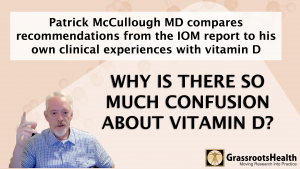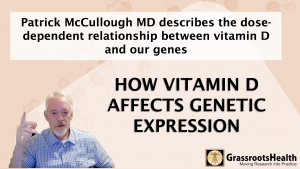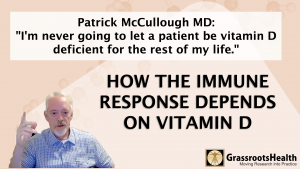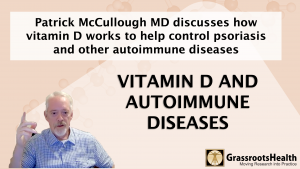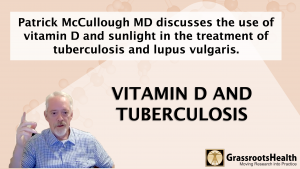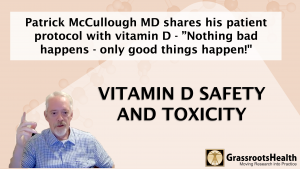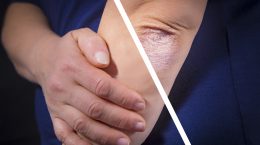Published on November 8, 2023
Check out these videos created from an interview with Dr. Patrick McCullough on topics from the IOM recommendations, to clinical experiences with autoimmune diseases and vitamin D, and vitamin D safety and toxicity
Key Points
- Dr. Patrick McCullough presents information on topics including:
- Why is there so much Confusion about Vitamin D?
- How Vitamin D Affects Genetic Expression: Dose-dependent relationship between vitamin D & our genes
- How the Immune Response Depends on Vitamin D
- How Vitamin D Helps Control Autoimmune Diseases
- Vitamin D and Tuberculosis and
- Vitamin D Safety and Toxicity
GrassrootsHealth had the honor of interviewing Dr. Patrick McCullough, MD, who is the author of several publications on vitamin D including two of his most recent, “Oral and Topical Vitamin D, Sunshine, and UVB Phototherapy Safely Control Psoriasis in Patients with Normal Pretreatment Serum 25-Hydroxyvitamin D Concentrations: A Literature Review and Discussion of Health Implications” and “Daily oral dosing of vitamin D3 using 5000 to 50,000 international units a day in long-term hospitalized patients: Insights from a seven year experience.”
Dr. McCullough began studying the published literature on vitamin D in 2009; he created his own vitamin D protocol for all of his patients and implemented it along with a blessing from top vitamin D researchers. Before the official recommendations on vitamin D were released by the Institute of Medicine (IOM) in 2011, he had already been utilizing high doses of vitamin D in his practice – and seeing many positive results. Had he been following the recommendations from the IOM, he would not have seen any of the results he has seen to this day.
Listen in to these first few videos created from this interview – there are more to come! Full transcripts for each of these videos can be found at vitamindwiki.com. And, send Dr. McCullough a huge “thank you” for staying up past midnight to give us all of this wonderful information 🙂
A big Thank You to Dr. McCullough!
Watch the Videos
 Why is there so much Confusion about Vitamin D?
Why is there so much Confusion about Vitamin D?
Why is there so much confusion about vitamin D? Dr. Patrick McCullough, MD, discusses the IOM’s vitamin D recommendations in comparison to his clinical experiences with vitamin D. He had been researching the vitamin D literature since 2009 and started treating patients in his hospital with vitamin D before the 2011 IOM report on vitamin D came out. He came up with own protocol based on literature, giving 10,000 IU as his standard of care. When the IOM report came out, it said that what he was doing was wrong, however, based on the results his patients were getting, he was only doing good!
He also discusses how his patients, many coming from ICU and long-term acute hospital care, had not been receiving vitamin D, had not been out in sunshine; some had vitamin D levels that were undetectable, and at least 60% had vitamin D levels less than 32 ng/ml.
His protocol is evidence based, and has been working well, with no negative effects.
@2:20 Dr. McCullough discusses several problems with the 2011 IOM report.
There are many deficiencies in the IOM report. First of all, it is based on the assumption that the only diseases that vitamin D could be beneficial for were bone diseases (rickets and osteoporosis) – they did not include any benefit of vitamin D for autoimmune diseases.
Addressing psoriasis (an autoimmune disease) with vitamin D has a history of published research – yet there is no mention of psoriasis in their report. Psoriasis treatment with vitamin D had even been resurrected, yet still no mention of it in IOM report.
The IOM recommendation was also not made based on how much vitamin D could be produced from sun exposure; instead, it was made based on how much vitamin D would be absorbed through the gut from food. Nothing in the diet comes close to providing as much vitamin D as proper sun exposure provides.
@6:00 Dr. McCullough discusses several phototherapy effects on diseases that work in part by restoring vitamin D status. His own paper on psoriasis included baseline and treated vitamin D levels; resulting levels with phototherapy alone (not supplementation) could get up to over 100 ng/ml, yet the IOM says not to go over 50 ng/ml. This is another case showing how the IOM did not acknowledging the literature on other diseases affected by vitamin D, especially psoriasis.
@9:28 Dr. McCullough describes his use of vitamin D in his current practice, with the collection of data to compare 5,000 IU to 10,000 IU vitamin D per day among his patients.
Asthma is also discussed – most studies give doses that are too low, showing no effect of vitamin D; 10,000 IU per day has helped several of his work colleagues with asthma. What is the best dose for asthma? These are the types of research studies that still need to be done…
As Dr. McCullough states, “We can safely control autoimmune diseases and other diseases with physiological levels of vitamin D!”
Read more about his papers here.
 How Vitamin D Affects Genetic Expression: Dose-dependent relationship between vitamin D & our genes
How Vitamin D Affects Genetic Expression: Dose-dependent relationship between vitamin D & our genes
In this video, Dr. Patrick McCullough reviews a paper by Shirvani et al. on the effects of 600, 4000, or 10,000 IU of vitamin D per day on gene function within white blood cells and how many genes were affected at each dose.
Learn more about this study here.
What does this mean, or what happens when genes are turned on or off?
Genes contain DNA sequences that make proteins – they are a blueprint for building something, and they must be deciphered.
Vitamin D acts as a ‘key’ to unlock DNA, and to turn the genes on or off. Genes contain “vitamin D response elements” that allow vitamin D to induce their genetic response. There are at least 2776 unique binding sites for vitamin D within our human genome. This implies that vitamin D controls at least that many genes, likely many more.
Our cells need access to enough vitamin D from the blood [as 25(OH)D] to be able to pull it in, convert it into its active form, and utilize it on demand.
The question becomes – how much vitamin D do we need to make sure all those vitamin D-dependent genes are happy?
Shirvani et al. showed that many more genes were turned on at a dose of 10,000 IU per day – what would 20,000 or 30,000 IU per day have done? This is more research that needs to be done…
 How the Immune Response Depends on Vitamin D
How the Immune Response Depends on Vitamin D
In this video, Dr. Patrick McCullough, MD, describes how vitamin D status affects T cell activity, and therefore the effectiveness of the immune system in controlling autoimmune diseases and cancers.
Regulatory T lymphocytes are called the Master Regulators of the Immune System; they are able to turn off autoimmune diseases. Research shows how restoring vitamin D status is also able to restore the functional status of regulatory T lymphocytes.
Vitamin D is also in charge of turning thousands of genes on or off. What happens when genes are “turned on” by vitamin D, and how does that in turn affect autoimmune diseases and other diseases?
Vitamin D controls thousands of genes, and while don’t know exactly what the gene products are or do, we can see the results, which includes lower rates of cancers, especially prostate, breast and colon cancer. As vitamin D levels increase, risk of cancer gets lower.
A landmark study published in 2006 by Liu et al. outlined the connection between vitamin D and the the production of antimicrobial peptides. Certain immune cells make antimicrobial peptides, which act as the body’s natural antibiotics, and are able to kill different types of microorganisms (bacteria, parasites, fungi, envelope viruses, etc.). This is a process that is dependent on vitamin D.
Unfortunately, most studies use doses of vitamin D that are too low; the key is to use the right amount of vitamin D to trigger the full immune response; it will not work with sub-physiological amounts of vitamin D.
As Dr. McCullough states, “I’m never going to let a patient be vitamin D deficient for the rest of my life…” His use of vitamin D with critically ill patients has been successful at getting many of them well, safely and without any signs of toxicity.
Read more about Dr. McCullough’s papers here.
 How Vitamin D Helps Control Autoimmune Diseases
How Vitamin D Helps Control Autoimmune Diseases
In this video, Dr. Patrick McCullough, MD, discusses how vitamin D works to help control psoriasis and other autoimmune diseases. Every autoimmune disease works the same way – it just affects a different part of the body.
Immune cells called regulatory T lymphocytes (Master Regulators of the Immune System) can turn autoimmune diseases off. Vitamin D causes the formation of and maintains the functional status of regulatory T lymphocytes – this is one mechanism of how vitamin D works to control psoriasis and other autoimmune diseases.
Dr. McCullough shares several personal experiences with vitamin D, and diseases that have improved with vitamin D, including
- Graves disease
- MS
- Reumatoid Arthritis
- Asthma
- Crohn’s Disease
- Psoriasis
- Vitaligo
Stopping vitamin D or decreasing the dose can cause symptoms to return – this is because “Autoimmune diseases are not cured by vitamin D, they are controlled with it.”
As Dr. McCullough states, “First cause no harm… in the IOM’s quest not to cause harm by giving too much, they are causing way more harm by not giving enough.”
Learn more about Dr. McCullough’s latest publications here.
 Vitamin D and Tuberculosis
Vitamin D and Tuberculosis
How does vitamin D work to cure diseases like tuberculosis and lupus vulgaris? Dr. Patrick McCullough, MD, discusses the use of vitamin D and sunlight in the treatment of tuberculosis and lupus vulgaris.
Niels Ryberg Finsen was the first to study the scientific effects of sunlight. In 1903, he won the Nobel Peace Award for his discovery of phototherapy treatment for the skin manifestation of tuberculosis, lupus vulgaris.
Listen in to this discussion of phototherapy treatments and the discovery of the vitamin D molecule, leading to supplementation to help control diseases such as tuberculosis and lupus.
Learn more here.
 Vitamin D Safety and Toxicity
Vitamin D Safety and Toxicity
Dr. Patrick McCullough, MD, shares his patient protocol with vitamin D when asked the question, “What are some of the additional components of your protocol besides vitamin D supplementation?”
Dr. McCullough had worked in a long-term acute care hospital, and now works at a state psychiatric hospital; over half of the patients have stayed there for over a year, some have been there for over 20 years. He has kept vitamin D records among his patients throughout these years, and many of them have been on his vitamin D protocol during the entirety of their care – which has resulted in lots of long-term data on the safety of vitamin D.
In his experience, treating patients with 10,000 IU vitamin D per day, sometimes more, is safe and does not cause kidney stones or renal issues. His findings have been published in his paper “Daily oral dosing of vitamin D3 using 5000 TO 50,000 international units a day in long-term hospitalized patients: Insights from a seven year experience.” Dr. McCullough was not going to cause harm – he checked labs twice per week for safety (complete metabolic profiles, intact PTH levels, serum calcium) along with vitamin D levels.
Previous research has shown a huge band of safety with vitamin D. A 2011 publication by Araki et al. reviewed vitamin D toxicity cases that resulted from labeling and manufacturing errors – no deaths were reported, each case resolved with complete recovery.
His patient protocol is to put all patients on 10,000 IU per day, and in his experience, “nothing bad happens – only good things happen!”
Test to See if You Are Getting Enough Vitamin D and Other Important Nutrients
 Create your custom home test kit to measure your levels at home as part of the D*action project!
Create your custom home test kit to measure your levels at home as part of the D*action project!
With your kit you can measure your:
- Vitamin D
- Magnesium PLUS Essential and Toxic Elements
- Omega-3 Fatty Acids
- hsCRP
- HbA1c
- TSH
- Type 1 Diabetes Autoantibodies
Did you know that each of the above can be measured at home using a simple blood spot test? As part of our ongoing research project, you can order your home blood spot test kit to get your levels, followed by education and steps to take to help you reach your optimal target levels. Start by enrolling and ordering your kit to measure each of the above important markers, and make sure you are getting enough of each to support better mood and wellbeing!
Create your custom home test kit today. Take steps to improve the status of each of these measurements to benefit your overall health. With measurement you can then determine how much is needed and steps to achieve your goals. You can also track your own intakes, symptoms and results to see what works best for YOU.


